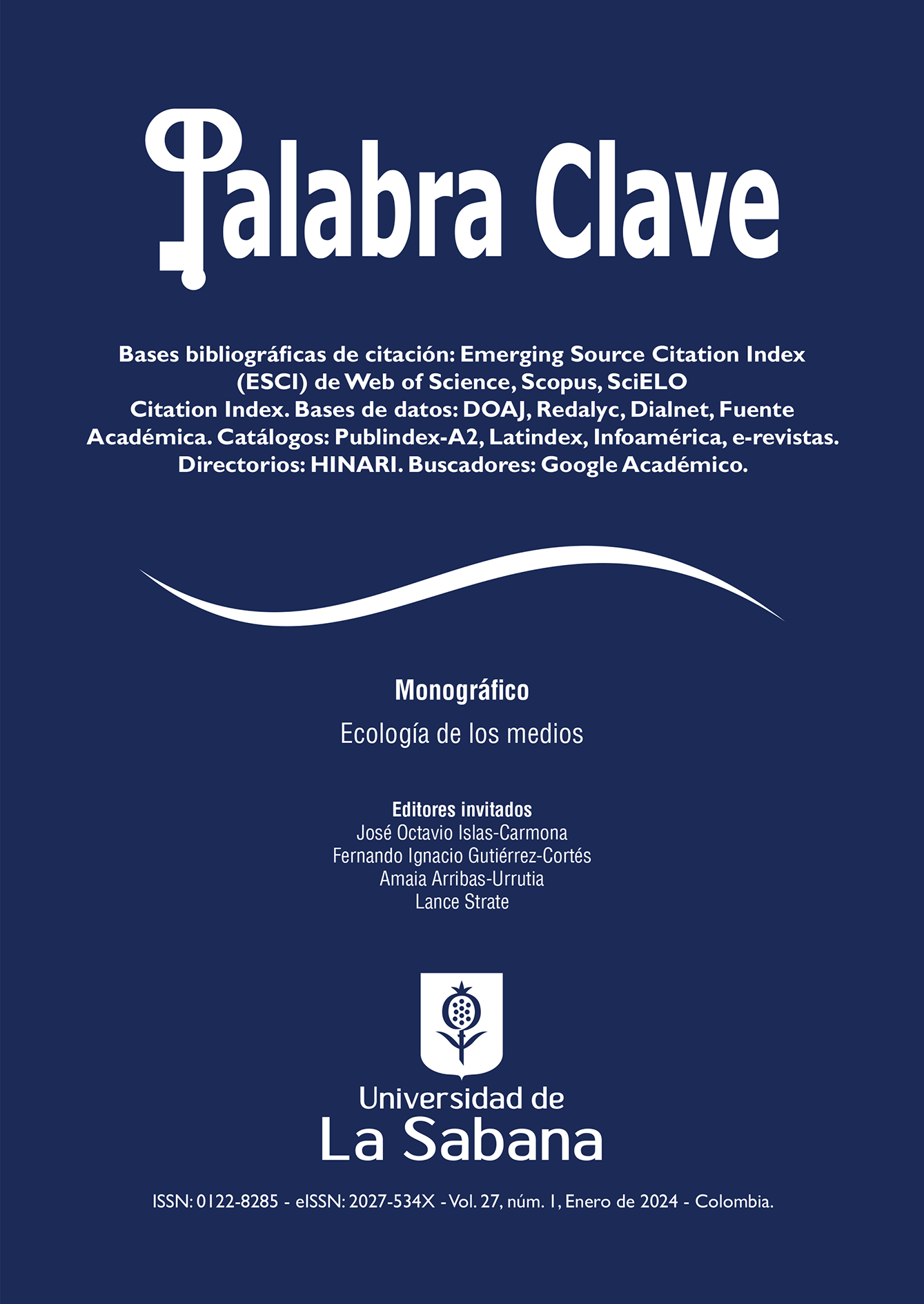Cartography of Media Consumption in Ecuador: From Mediations and Hyper-mediations to an Ultra-mediated Society
DOI:
https://doi.org/10.5294/pacla.2024.27.1.2Keywords:
Convergence, media ecology, hyper-mediation, internet, media, ultra-mediationAbstract
The phenomenon of ultra-mediations is made up of the evolution of media ecology, convergence, and hyper-mediation, all constituted based on technology and the human being as the architect of its development. Just as in economic theory, in ultra-mediations, networks generate behavioral patterns and interactions influence the results of coordination and cooperation. So, a diversity of actions is sustainable with certain network structures, but not with others; Therefore, people function as nodes due to differences in their connections and their history will depend on the network to which they belong. This research addresses the bases of ultra-mediations and, subsequently, analyzes how Ecuador integrates into this phenomenon through the exploration of variables collected in the 2019 Multiple Purpose Survey and the 2022 Employment Survey of the National Institute of Statistics and Censuses (INEC). It is concluded that, in Ecuador, the pandemic reduced the gap in the use of social networks; which can be interpreted as a better assimilation and participation of connections between nodes and users in ultra-mediations; However, Internet penetration remains the first obstacle to creating more egalitarian development.
Downloads
References
Bustamante, E. (2017). Las industrias culturales y creativas. Periférica, 18, 89-117.
Chanona Burguete, O. (2017). Digitalidad: cambios y mutaciones en la cotidianidad. Revista Digital Universitaria, 18(4). https://www.revista.unam.mx/ojs/index.php/rdu/article/view/1020
Cruces, F. (2008). Matrices culturales: pluralidad emoción y reconocimiento. Anthropos, 219, 173-180.
De Fleur, M. L. y Ball-Rokeach, S. J. (1993). Teorías de la comunicación de masas. Paidós.
Goyal, S. (2007). Connections: An Introduction to the Economics of Networks. Sanjeev Goyal. https://doi.org/10.1515/9781400829163
Hall, S. (1981). La cultura, los medios de comunicación y el “efecto ideológico”. En J. Curran, Gurevitch, M. y Wollacot, J. (eds.), Sociedad y comunicación de masas. Fondo de la Cultura Económica.
INEC - Instituto Nacional de Estadística y Censos (2019). Encuesta multipropósito 2019. https://www.ecuadorencifras.gob.ec/encuesta-nacional-multiproposito-de-hogares-2019/
INEC - Instituto Nacional de Estadística y Censos (2019). Encuesta multipropósito julio 2022. https://www.ecuadorencifras.gob.ec/encuesta-nacional-multiproposito-de-hogares/
Islas, O. (2009). La convergencia cultural a través de la ecología de medios. Comunicar, 16(33), 25-33. https://doi.org/10.3916/c33-2009-02-002
Jenkins, H. (2008). Convergence culture: la cultura de la convergencia de los medios de comunicación. Paidós.
Jenkins, H. (2010). Ludic Narrans: Drew Davidson talks cross-media communication (Part One). Pop Junctions.
López, A. (2017). Marshall McLuhan, el visionario de la “aldea global” de la comunicación. El País. https://elpais.com/cultura/2017/07/21/actualidad/1500619102_672795.html
Martín-Barbero, J. M. (1983). Memoria narrativa e industria culturale. La Ricerca Folklorica, 7, 9. https://doi.org/10.2307/1479711
Martín-Barbero, J. (2018). Preámbulo a un mapa de las mutaciones comunicativas y culturales. En O. Rincón (ed.), Pensar desde el Sur. Reflexiones acerca de los 30 años de los medios a las mediaciones de Jesús Martín-Barbero. FES-ILDIS.
Mason, J. (2002). Qualitative Researching. Sage.
McLuhan, M. y Powers, B. R. (2010). La aldea global. Gedisa.
McLuhan, M. y Fiore, Q. (1992). El medio es el masaje. Un inventario de efectos. Paidós.
Pariser, E. (2011). The filter bubble: What the Internet is hiding from you. Penguin.
Postman, N. (2015). El humanismo de la ecología de los medios. En C. Scolari (ed.), Ecología de los medios. Entornos, evoluciones e interpretaciones. Gedisa.
Querejeta Barceló, A. (2018). Roland Barthes, el texto y el poder. Per Debate, 1. https://doi.org/10.18272/pd.v1i0.1200
Rodríguez, C. (2017). Los usuarios en su laberinto: burbujas de filtros, cámaras de eco y mediación algorítmica. Virtualis, 8(16), 57-76. https://www.researchgate.net/publication/338517284
Roig, A. (2009). Cine en conexión: producción industrial y social en la era “cross-media”. UOC.
Scolari, C. (2008). Hipermediaciones: elementos para una teoría de la comunicación digital interactiva. Gedisa.
Scolari, C. (2018). Las leyes de la interfaz. Diseño, ecología, evolución, tecnología. Gedisa.
Sotelo González, J. (2011). Si McLuhan levantara la cabeza... La computación en la nube y el nuevo paradigma sociocultural. Revista de Estudios de Juventud, 92, 111-121. https://dialnet.unirioja.es/servlet/articulo?codigo=5047339
Vizer, E. y Carvalho, H. (2014). La caja de Pandora: tendencias y paradojas de las TIC. En Lo que McLuhan no predijo. La Crujía.
Published
How to Cite
Issue
Section
License
Copyright (c) 2024 Marco López-Paredes, Andrea Carrillo-Andrade

This work is licensed under a Creative Commons Attribution 4.0 International License.
1. Proposed Policy for Journals That Offer Open Access
Authors who publish with this journal agree to the following terms:
- Authors retain copyright and grant the journal right of first publication with the work simultaneously licensed under a Creative Commons Attribution License that allows others to share the work with an acknowledgement of the work's authorship and initial publication in this journal.
Funding data
-
Pontificia Universidad Católica del Ecuador
Grant numbers PEP QINV0353-IINV522010100









